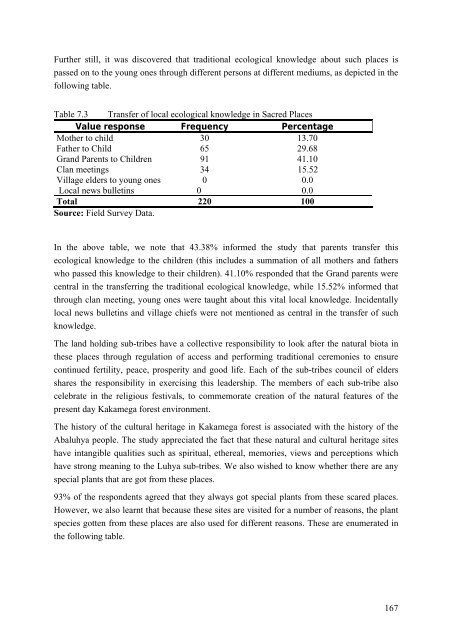THE UNIVERSITY OF LEIPZIG
THE UNIVERSITY OF LEIPZIG
THE UNIVERSITY OF LEIPZIG
You also want an ePaper? Increase the reach of your titles
YUMPU automatically turns print PDFs into web optimized ePapers that Google loves.
Further still, it was discovered that traditional ecological knowledge about such places is<br />
passed on to the young ones through different persons at different mediums, as depicted in the<br />
following table.<br />
Table 7.3 Transfer of local ecological knowledge in Sacred Places<br />
Value response Frequency Percentage<br />
Mother to child 30 13.70<br />
Father to Child 65 29.68<br />
Grand Parents to Children 91 41.10<br />
Clan meetings 34 15.52<br />
Village elders to young ones 0 0.0<br />
Local news bulletins 0 0.0<br />
Total 220 100<br />
Source: Field Survey Data.<br />
In the above table, we note that 43.38% informed the study that parents transfer this<br />
ecological knowledge to the children (this includes a summation of all mothers and fathers<br />
who passed this knowledge to their children). 41.10% responded that the Grand parents were<br />
central in the transferring the traditional ecological knowledge, while 15.52% informed that<br />
through clan meeting, young ones were taught about this vital local knowledge. Incidentally<br />
local news bulletins and village chiefs were not mentioned as central in the transfer of such<br />
knowledge.<br />
The land holding sub-tribes have a collective responsibility to look after the natural biota in<br />
these places through regulation of access and performing traditional ceremonies to ensure<br />
continued fertility, peace, prosperity and good life. Each of the sub-tribes council of elders<br />
shares the responsibility in exercising this leadership. The members of each sub-tribe also<br />
celebrate in the religious festivals, to commemorate creation of the natural features of the<br />
present day Kakamega forest environment.<br />
The history of the cultural heritage in Kakamega forest is associated with the history of the<br />
Abaluhya people. The study appreciated the fact that these natural and cultural heritage sites<br />
have intangible qualities such as spiritual, ethereal, memories, views and perceptions which<br />
have strong meaning to the Luhya sub-tribes. We also wished to know whether there are any<br />
special plants that are got from these places.<br />
93% of the respondents agreed that they always got special plants from these scared places.<br />
However, we also learnt that because these sites are visited for a number of reasons, the plant<br />
species gotten from these places are also used for different reasons. These are enumerated in<br />
the following table.<br />
167






